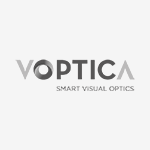Purpose: Although there are many types of IOLs to correct presbyopia currently available, their final performance maybe strongly patient dependent. Adaptive optics (AO) based visual testing has been proposed to optimize the opticalcorrection before clinical intervention. The validity of this approach is based on laboratory studies (Schwarz et al.,ARVO 2014). The aim of this work was to extend this method to the standard clinical practice.
Methods: A commercially available clinical AO visual simulator (AOnEye, Voptica SL, Spain) was used. This instrument combines objective wavefront sensing with subjective visual testing for different induced optical phase profiles. Those are generated with a liquid crystal spatial light modulator which is conjugated with the patient’s pupil plane. Visual stimuli are projected by an micro OLED. Through focus visual acuity (VA) was measured (0, 1, 1.5, 2.0 and 3.0 D of object’s vergence). Four different lens profiles were evaluated. Two diffractive multifocal IOLs (bifocal and trifocal) and two IOLs with extended depth of focus (DOF) (mild/strong: sphere +0,75/+1,30; spherical aberration -0,1/-0,4 μm for 4,5 mm pupil). Unpaired t-statistics was used to analyze the difference between the fixation distances. P-values smaller than 0.05 were considered significant. The results were compared with theoretical predictions.
Results: The bifocal design showed significant better VA for the two focus distances (0 and 3D). The mean (M) and standard deviation (SD) of VA in decimal at the peaks was 0.81 ± 0.16 and 0.57 ± 0.13 at the other distances. The trifocal design showed no significant difference between the distances (M ± SD: 0.74 ± 0.15). The mild DOF lens showed a plateau at the intermediate values (1, 1.5 and 2D) and a decrease for far and near vision (worst for near). With VA of 0.71 ± 0.11, 0.93 ± 0.23 and 0.46 ± 0.14 for respectively far, intermediate and near. The strong DOF gave an improvement in VA with decreasing distance, with a minimum of 0.46 ± 0.13 at far and a maximum of 0.86 ± 0.15 at near. Both diffractive profiles performed as theoretically predicted. The degradation of far vision for the DOF profiles deviates from the expectations.
Conclusions: A clinical adaptive optics visual simulator proved to be functional to test presbyopic correcting profiles in prospective cataract patients. This instrument would permit customization/selection of the optimal IOL for each patient.
Methods: A commercially available clinical AO visual simulator (AOnEye, Voptica SL, Spain) was used. This instrument combines objective wavefront sensing with subjective visual testing for different induced optical phase profiles. Those are generated with a liquid crystal spatial light modulator which is conjugated with the patient’s pupil plane. Visual stimuli are projected by an micro OLED. Through focus visual acuity (VA) was measured (0, 1, 1.5, 2.0 and 3.0 D of object’s vergence). Four different lens profiles were evaluated. Two diffractive multifocal IOLs (bifocal and trifocal) and two IOLs with extended depth of focus (DOF) (mild/strong: sphere +0,75/+1,30; spherical aberration -0,1/-0,4 μm for 4,5 mm pupil). Unpaired t-statistics was used to analyze the difference between the fixation distances. P-values smaller than 0.05 were considered significant. The results were compared with theoretical predictions.
Results: The bifocal design showed significant better VA for the two focus distances (0 and 3D). The mean (M) and standard deviation (SD) of VA in decimal at the peaks was 0.81 ± 0.16 and 0.57 ± 0.13 at the other distances. The trifocal design showed no significant difference between the distances (M ± SD: 0.74 ± 0.15). The mild DOF lens showed a plateau at the intermediate values (1, 1.5 and 2D) and a decrease for far and near vision (worst for near). With VA of 0.71 ± 0.11, 0.93 ± 0.23 and 0.46 ± 0.14 for respectively far, intermediate and near. The strong DOF gave an improvement in VA with decreasing distance, with a minimum of 0.46 ± 0.13 at far and a maximum of 0.86 ± 0.15 at near. Both diffractive profiles performed as theoretically predicted. The degradation of far vision for the DOF profiles deviates from the expectations.
Conclusions: A clinical adaptive optics visual simulator proved to be functional to test presbyopic correcting profiles in prospective cataract patients. This instrument would permit customization/selection of the optimal IOL for each patient.


